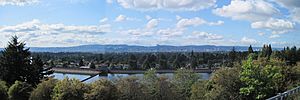Mount Tabor, Portland, Oregon facts for kids
Quick facts for kids
Mount Tabor
|
|
|---|---|
|
Neighborhood
|
|

Downtown Portland, Oregon, seen from Mount Tabor Park.
|
|
| Country | United States |
| State | Oregon |
| City | Portland |
| Area | |
| • Total | 1.60 sq mi (4.14 km2) |
| Population
(2020)
|
|
| • Total | 10,751 |
| • Density | 6,719/sq mi (2,594/km2) |
| Housing | |
| • No. of households | 4756 |
| • Occupancy rate | 93.9% occupied |
| • Owner-occupied | 2808 households (65%) |
| • Renting | 1508 households (35%) |
| • Avg. household size | 2.2 persons |
| Race Distribution: White 81%, Asian 7.5%, Hispanic 6.2%, Black 2.8% | |
Mount Tabor is a neighborhood in Southeast Portland that takes its name from the volcanic cinder cone and city park on the volcano that it surrounds, in the U.S. state of Oregon. The name refers to Mount Tabor, Israel. It was named by Plympton Kelly, son of Oregon City pioneer resident Clinton Kelly.
Neighborhood
The Mount Tabor neighborhood lies between SE 49th Ave. (SE 50th Ave. south of SE Hawthorne Blvd.) on the west and SE 76th Ave. on the east, and between E Burnside St. on the north and SE Division St. on the south. It is bordered by Sunnyside and Richmond on the west, North Tabor on the north and west, Montavilla on the north and east, and South Tabor on the south.
Mount Tabor Park is the neighborhood's principal feature. The campus of Warner Pacific University (affiliated with the Church of God (Anderson)) is located just south of the park. The neighborhood also marks the eastern end of the Hawthorne District. The campus of Western Seminary is located on the western slope, overlooking downtown Portland.
History
Before becoming part of Portland in 1905, Mount Tabor was a rural farming community dating back to the 1850s. After a large wildfire burnt much of Mount Tabor's landscape in 1846, trails and farmhouses began to appear in the area. In 1903, John C. Olmstead submitted a report to Portland that the city should acquire "considerable land on this prominent and beautiful hill", and it was annexed two years later.
It became a city-recognized neighborhood (encompassing a far smaller area than its historical boundaries) in 1974.
| Historical population | |||
|---|---|---|---|
| Census | Pop. | %± | |
| 2000 | 10,037 | — | |
| 2010 | 10,196 | 1.6% | |
| 2020 | 10,751 | 5.4% | |



